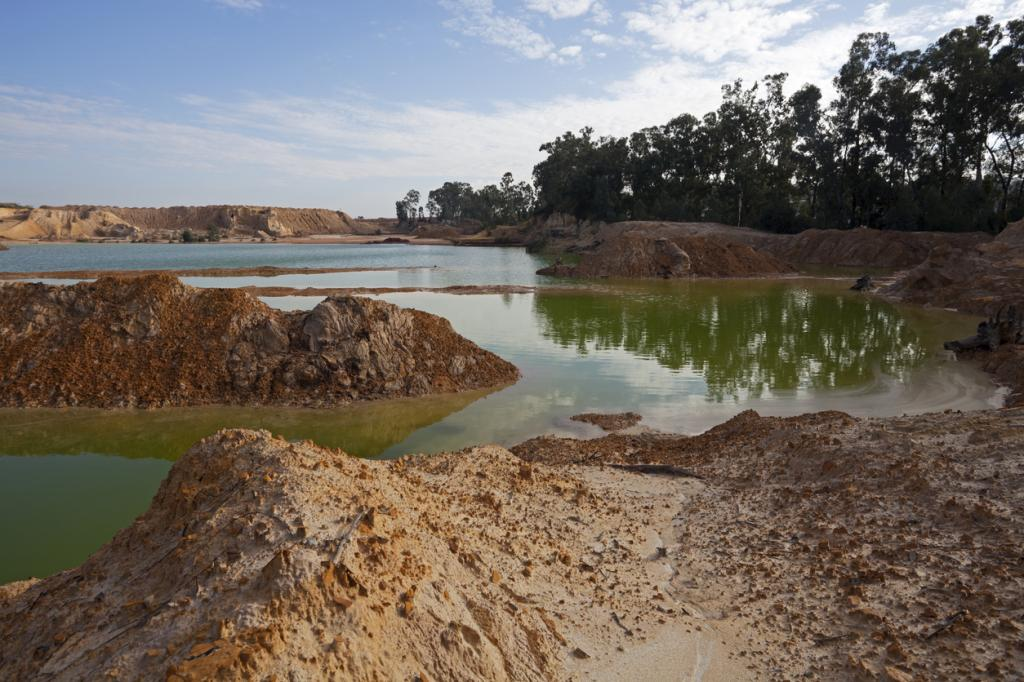Description

Copyright infringement not intended
Picture Courtesy: https://www.downtoearth.org.in/blog/africa/south-africa-gold-mine-pollution-is-poisoning-soweto-s-water-and-soil-study-finds-food-gardens-are-at-risk-96323
Context: Gold mine pollution in Johannesburg, South Africa contaminates water and soil with heavy metals, impacting Soweto residents and urging urgent government intervention.
Details
- For over a century, gold mines in Johannesburg, South Africa, have been releasing contaminated wastewater into the environment, posing serious health risks to nearby communities. This toxic cocktail includes heavy metals like uranium, arsenic, copper, cobalt, and lead, which can wreak havoc on both land and water sources.
Acid Mine Drainage and Urban Agriculture
- Recent research conducted by environmental scientists sheds light on how acid mine drainage impacts urban agriculture in Soweto, particularly through contamination of water sources and soil.
- Health Risks: Exposure to heavy metals from acid mine drainage can lead to various health issues, ranging from mild dehydration and abdominal pain to more severe conditions like birth defects, cancer, and brain damage.
- Responsibility of Mining Companies: Despite regulations requiring mining companies to set aside funds for environmental rehabilitation, past failures in compliance have exacerbated the problem. Remediation efforts, such as chemical treatments and wetland construction, are crucial but often insufficient.
Impact on Residents
- Direct Exposure: Residents living near mine dumps face the highest risk, with artisanal miners (locally known as "zama-zamas") particularly vulnerable due to their close contact with acid mine drainage.
- Health Concerns: Heavy metal contamination not only affects agricultural land but also poses risks to residents through contaminated soil and airborne dust.
Recommendations for Action
- Decommissioning of Abandoned Mines: Proper closure of abandoned mines is essential to prevent further pollution.
- Relocation and Rehabilitation: Residents living in close proximity to mine dumps should be relocated, and rehabilitation programs must be implemented to sustain urban agriculture.
- Government Intervention: The government needs to prioritise the health and well-being of Soweto's residents by taking decisive action to address acid mine drainage and its consequences.
Sustainable Mining
- Sustainable mining refers to the responsible extraction of natural resources while minimising negative environmental, social, and economic impacts.
- It involves integrating principles of environmental stewardship, social responsibility, and economic viability into mining practices to ensure the long-term well-being of communities, ecosystems, and economies.
Principles of Sustainable Mining
- Economic Viability: Sustainable mining operations must be financially profitable, ensuring economic benefits for stakeholders while maintaining long-term viability.
- Environmental Responsibility: Mining activities should minimise environmental degradation, conserve natural resources, and mitigate negative impacts such as pollution and habitat destruction.
- Social Equity: Sustainable mining fosters inclusive development, respects human rights, and engages with local communities to ensure equitable distribution of benefits and opportunities.

Key Components of Sustainable Mining
Environmental Management
- Regulatory Compliance: Mining companies adhere to stringent environmental regulations and obtain permits for exploration, extraction, and closure activities. These regulations are established by government agencies to protect air, water, and land resources.
- Environmental Impact Assessments (EIAs): Prior to commencing mining operations, companies conduct EIAs to evaluate potential environmental impacts and develop mitigation measures to minimise harm.
- Rehabilitation and Closure Planning: Sustainable mining involves proactive measures to rehabilitate mined areas and restore ecosystems post-closure. Companies develop closure plans to address land reclamation, water treatment, and vegetation restoration.
Social Responsibility
- Community Engagement: Mining companies engage with local communities through consultation, dialogue, and participatory decision-making processes. They collaborate with stakeholders to identify concerns, address grievances, and implement community development projects.
- Indigenous Rights: Respect for indigenous rights and traditional knowledge is integral to sustainable mining. Companies collaborate with indigenous communities to uphold cultural heritage, protect sacred sites, and ensure meaningful participation in decision-making.
- Labour Practices: Sustainable mining prioritises worker safety, health, and well-being. Companies implement robust occupational health and safety (OHS) policies, provide training and capacity-building opportunities, and promote fair labour practices.
Economic Development
- Local Procurement: Mining companies support local economies by sourcing goods and services from nearby suppliers. This promotes economic growth, creates employment opportunities, and fosters entrepreneurship in mining regions.
- Royalties and Taxes: Governments receive revenue from mining operations through royalties, taxes, and other fiscal mechanisms. These funds are invested in public infrastructure, social services, and environmental conservation efforts.
|
Examples of Sustainable Mining Practices
●Rio Tinto's Rehabilitation of Bauxite Mines: Rio Tinto, a global mining company, implements comprehensive rehabilitation programs to restore bauxite mining areas in Australia. Through revegetation, soil stabilisation, and water management initiatives, Rio Tinto aims to rehabilitate mined land and promote biodiversity conservation.
●Barrick Gold's Community Development Initiatives: Barrick Gold, one of the world's largest gold mining companies, implements community development projects in partnership with local stakeholders. From education and healthcare to infrastructure and livelihood support, Barrick Gold's initiatives contribute to sustainable socio-economic development in mining communities.
|
Challenges and Considerations
- Balancing economic benefits with environmental and social costs remains a challenge.
- Implementing sustainable practices often requires upfront investment, which may be a barrier for some mining companies.
- Effective enforcement of regulations and standards is crucial for ensuring responsible mining practices.
Conclusion
- Sustainable mining is essential for balancing resource extraction with environmental protection, social equity, and economic development. By integrating responsible practices into their operations, mining companies can minimise negative impacts and maximise positive outcomes for stakeholders and ecosystems alike. Ongoing collaboration between governments, industry, communities, and civil society is crucial for advancing sustainable mining practices globally.
Source:
Down To Earth
World Bank
|
PRACTICE QUESTION
Q. Explain the concept of "circular economy" and how it can be applied to the mining industry to promote sustainability. What are the key challenges in implementing a circular approach for mining operations and mineral supply chains?
|













